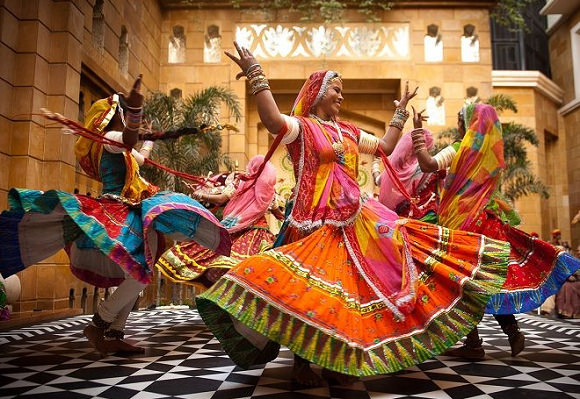
Ghoomar, also known as Jhumar, is a traditional folk dance synonymous with the Indian state of Rajasthan. Its name comes from the word “ghoomna”, meaning pirouetting or spinning around, and hence is also colloquially referred to as the round-and-round dance.
This dance form was originally started by the Bhil community and was performed to worship the goddess Sarasvati. The Kachwahas clan of Rajputs who ruled Jaipur were at constant war with the Bhil tribe. After defeating them, they agreed to live in harmony with each other. Given the closeness of both the tribes, the royal Rajput clan embraced some of the traditions and practices of the Bhils, including Ghoomar, which thereafter began being associated with royalty.
Symbolism and significance
Traditionally, in addition to being just a dance form, Ghoomar was also meant to be symbolic of femininity. Young girls took part in this dance, thereby publicly announcing their entry into womanhood. Nowadays, this dance is performed by women of all ages across all Rajasthani families, irrespective of their royal status, on special occasions such as weddings and religious festivals. It is also a part of the traditional rituals of marriage in Rajasthan where a bride is expected to dance the Ghoomar after being welcomed at her husband’s home. Given its rich heritage and popularity, it has assumed the status of 'folk dance of the state'.
A dance routine that’s grace personified
 The dance is mostly performed by a group of women but can also be performed solo. The rhythm is upbeat and the women use graceful and elegant gestures, like pirouettes, finger-snapping, beating palms, and other hand and foot movements to maintain the tempo. It also includes a popular signature step called ghoomna, which involves women twirling around while their ghagra creates a whirling effect. To add variety to the routine, some Ghoomar performers dance and gyrate with brass pitchers or earthen pots on their heads or use fire lamps. The coordinated movements among women, along with their swirling colorful attire, make the dance an absolute joy to watch.
The dance is mostly performed by a group of women but can also be performed solo. The rhythm is upbeat and the women use graceful and elegant gestures, like pirouettes, finger-snapping, beating palms, and other hand and foot movements to maintain the tempo. It also includes a popular signature step called ghoomna, which involves women twirling around while their ghagra creates a whirling effect. To add variety to the routine, some Ghoomar performers dance and gyrate with brass pitchers or earthen pots on their heads or use fire lamps. The coordinated movements among women, along with their swirling colorful attire, make the dance an absolute joy to watch.
Based on popular Marwari tradition, Ghoomar often includes traditional songs such as "Gorband", "Podina", "Rumal" and "Mor Bole Re". These songs could be centered on royal legends or their traditions. Each region has its own unique way of performing the Ghoomar dance. One can find a touch of Garba in the way it is performed in Udaipur while in Jodhpur, the dance involves intense limb movements. The Ghoomar performed in the Kota-Bundi region is considered the most popular variant given that it is accompanied by fast and catchy tunes. Apart from the skill and precision, Ghoomar also requires a lot of stamina since it could go on for hours.
Colorful attire that enhances the visual appeal
A distinct feature that further enhances the enduring popularity of this traditional dance form is the beautiful and colorful costumes. Women perform Ghoomar wearing a veil on their head called ghoonghat and donning a flowing traditional outfit called ghagra choli. Colors like red and green with golden colored embroidery that is supposed to indicate prosperity and high spirits are popularly used in these dresses. The dot patterns of bandhani in the dress, mirror work, kundan jewelry, shining necklaces, colorful bangles form the adorning accessories that further enhance the visual appeal of the dresses. Ghoomar has had a significant contribution in popularizing outfits like Chaniya Choli or Ghagra Choli which is adorned by girls in most traditional festivals.
In 2018, Ghoomar received much recognition after it was performed in a Bollywood movie by a leading actress. Watch the video that beautifully encapsulates the spirit and character of Ghoomar.
TO READ THE FULL ARTICLE

Get full access to the exciting content on The Mirrority by logging in
Support independent journalism
Even the very best of media houses in our country today are yielding to the pressure of click-bait journalism in order to survive. More than ever before, our country needs journalism that is independent, fair and non-pliant to the bureaucracy. Such journalism needs the support of like-minded readers like you to help us survive editorially and financially.
Whether you live in India or India lives inside you, help us continue to produce quality journalism with your contribution.
CONTRIBUTE
